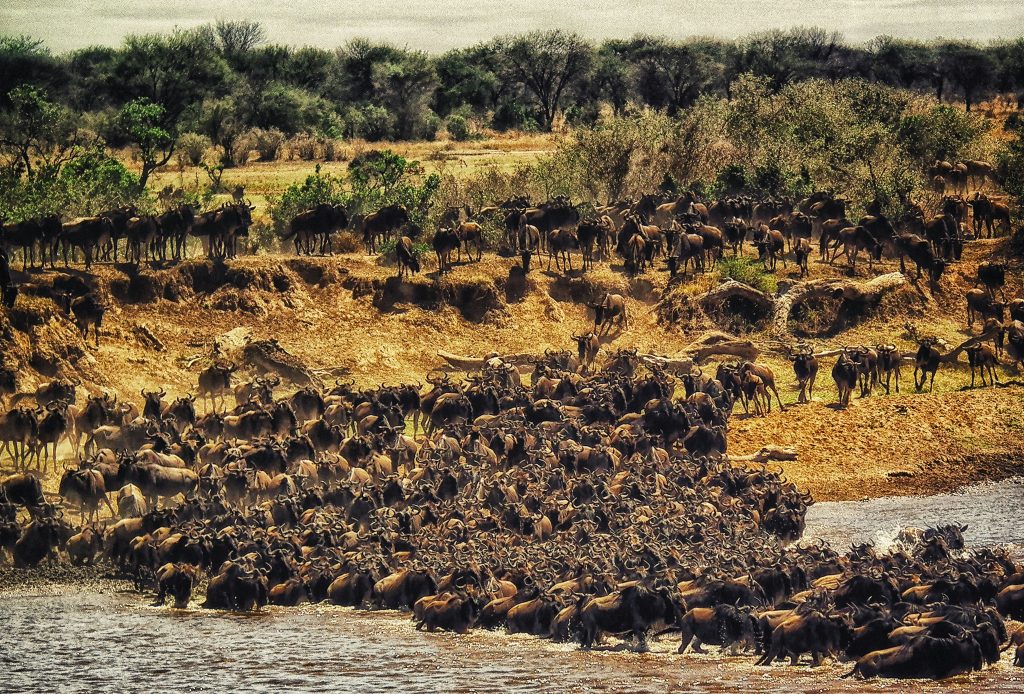Serengeti National Park
Maasai people called this park ‘Siringet’, meaning endless plains. The Serengeti speaks for itself and with good reason not only the migration of over 1 million wildebeest through its plains and woodlands but also unique landscapes and other spectacular wildlife.
Home to the world’s largest populations of Wildebeest, Zebra, Cape Eland, Lion,Cheetah, Hyena
and Gazelles. The scenic beauty of the sky in contrast with the land makes your visit incredible and cannot be missed!
Established in 1930 as game reserve, in 1940 become National Park and in 1981 become UNESCO World Heritage Sites.
Serengeti has the highest concentration of carnivores especially all the big African cats such as Lions, Leopards, Cheetah and Spotted Hyena!
More than 28 species of herbivores including buffalos, wildebeest, zebras, elands, hippos and 500 species of birdlife, and ideal place for bird lovers! Some of the species including European and Abdim’s storks, Eurasian Roller, Barn Swallows, Fish & Martial Eagles.
Seeing these powerful predators and diversity wildlife makes your day! Plan a visit!
If you dream of witnessing one of nature’s most spectacular overland migrations and encountering the Big Five, Serengeti National Park is your ultimate safari destination.

Climate
It is possible to do game drives in the Serengeti at any time of the year thanks to the abundance of resident animals.
The climate of the Serengeti National Park is subtropical, with dry season from May to October, and rain season from November to April. The park is located at an altitude between 900 and 2,000 meters.
If you dream of witnessing one of nature’s most spectacular overland migrations and encountering the Big Five, Serengeti National Park is your ultimate safari destination.
The Great Migration
The great wildebeest migration of over 1.3 million accompanied by large numbers of zebra, and smaller numbers of Grant’s & Thomson’s gazelle, eland and impala with an annual pattern seeking fresh grazing and water.
Between December and March you can witness the Great Migration in the Ndutu area when the animals move from North to South, from July to October, you will follow the animals that go up from the South to North in the Great Migration summer path through the areas of Lobo, Bologonya and Mara.
Having a chance of encountering this phenomena gives you a life time experience from nature.
Serengeti’s rivers
The Mara and Grumeti rivers are full of big crocodiles, the wildebeest and zebras Great Migration crosses those rivers every year. The Seronera river gives its name to the central area of the Serengeti Park and the Mbalageti river flows in the Western side of the park.
The Mara River
From July to October in the North of the Serengeti the Great Migration crosses the Mara River, the
cross is very difficult… crocodiles, strong stream, steep banks and other obstacles are waiting…
Many animals die crushed by others or fall during the descent or ascent of the river.
Crossing can take hours to make up their minds, finding the courage to face the dangers.
The Seronera River
The Seronera River is the most famous and visited, over 30 kilometers long, located in the Central
Serengeti. Several games drive pass along the river with excellent chances of spotting predators
such as lions, leopards, and cheetahs.
The Grumeti River
Safaris in May, June, and July usually take place between the Central Serengeti and the Western
looking for the Great Migration. Between the end of May and mid-July the Great Migration crosses
the Grumeti River, it is not very difficult cross, but… the crocodiles are waiting for this moment for
months and hide in the river to ambush the animals!
The Mbalageti River
The Mbalageti River is located in the Western Corridor, a little-visited area of the park, where we
find the Great Migration in May and June.
About Serengeti National Park
- Size: 14,763 square kilometers (5,700 square miles)
- Location: 2555 km from Arusha, bordered to the north with Kenya and to the west with Lake Victoria.
- Famous are the Serengeti kopjes, rocky islands that dot the plain, where many animals find shelter. The most famous are Simba Kopjes, Moru Kopjes and Masai Kopjes which you can visit during the photo safari.
- The Serengeti National Park Map.
- Sign up for our Newsletter
- Get travel inspiration, destination guides, and expert tips delivered straight to your inbox.
- By signing up for our mailing list, you agree to our privacy policy
- Terms and Conditions
- Privacy Policy